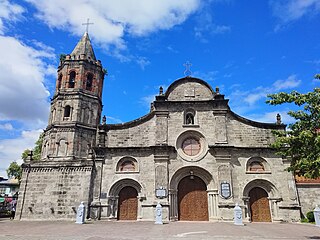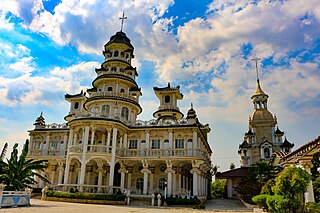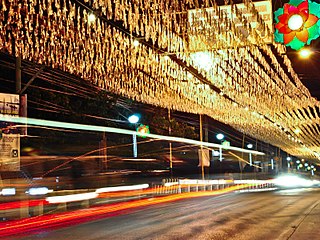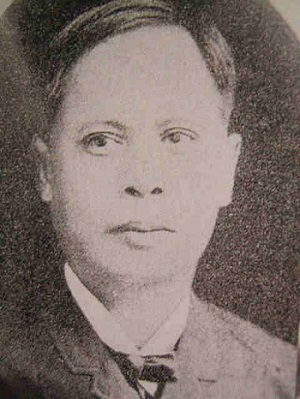
The Katipunan, officially known as the Kataastaasang Kagalanggalangang Katipunan ng mga Anak ng Bayan and abbreviated as the KKK, was a revolutionary organization founded in 1892 by a group of Filipino nationalists Deodato Arellano, Andrés Bonifacio, Valentin Diaz, Ladislao Diwa, José Dizon, and Teodoro Plata. Its primary objective was achieving independence from the Spanish Empire through an armed revolution. It was formed as a secret society before its eventual discovery by Spanish authorities in August 1896. This discovery led to the start of the Philippine Revolution.

Bulacan, officially the Province of Bulacan, is a province in the Philippines located in the Central Luzon region. Its capital is the city of Malolos. Bulacan was established on August 15, 1578, and part of the Metro Luzon Urban Beltway Super Region.

San Jose del Monte, officially the City of San Jose del Monte, is a 1st class component city in the province of Bulacan, Philippines. According to the 2020 census, it has a population of 651,813 people, making it the largest local government unit within the province of Bulacan and Central Luzon, and the 18th most populated city in the Philippines.

Bulakan, officially the Municipality of Bulakan, is a 1st class municipality in the province of Bulacan, Philippines. According to the 2020 census, it has a population of 81,232 people.

Bocaue, officially the Municipality of Bocaue, is a 1st class municipality in the province of Bulacan, Philippines. According to the 2020 census, it has a population of 141,412 people.

The Philippine Revolution was a war of independence waged by the revolutionary organization Katipunan against the Spanish Empire from 1896 to 1898. It was the culmination of the 333-year colonial rule of Spain in the archipelago. The Philippines was one of the last major colonies of the Spanish Empire, which had already suffered a massive decline in the 1820s. Cuba rebelled in 1895, and in 1898, the United States intervened and the Spanish soon capitulated. In June, Philippine revolutionaries declared independence. However, it was not recognized by Spain, which sold the islands to the United States in the Treaty of Paris.

Gregorio Hilario del Pilar y Sempio was a Filipino general of the Philippine Revolutionary Army during the Philippine–American War.

Santa Maria, officially the Municipality of Santa Maria, is a 1st class urban municipality in the province of Bulacan, Philippines. According to the 2020 census, it has a population of 289,820 people. representing 7.8% of the population of the province.

Balagtas, officially the Municipality of Balagtas, is a 1st class municipality in the province of Bulacan, Philippines. According to the 2020 census, it has a population of 77,018 people. The municipality is 30 kilometers (19 mi) from Manila and is 15 kilometers (9.3 mi) from Malolos City.

Pandi, officially the Municipality of Pandi, is a 2nd class municipality in the province of Bulacan, Philippines. According to the 2020 census, it has a population of 155,115 people.

Deodato Arellano y de la Cruz was a Filipino propagandist and the first president of the Katipunan, which was founded at his home in Azcarraga Street, Manila. He was first to be given the title Supremo by the Katipunan. After studying bookkeeping in Ateneo de Municipal de Manila, he became an assistant clerk for the Spanish military. He was a member of the Freemasonry in the Philippines and became involved in the Propaganda Movement.
General Aquilino Tiburcio de León y Gregorio Tolomeo was a Filipino freedom fighter who was a general during the 1896 Philippine Revolution and the Philippine–American War. He first served under Andrés Bonifacio in the Katipunan, and then, reluctantly, under the revolutionary government formed by Emilio Aguinaldo.
Bulacan is a province of the Philippines. It was established on 15 August 1578.
1898 in the Philippines details events of note that happened in the Philippines in the year 1898.

José Olaguer Feliú y Ramírez was a Spanish lieutenant general, Minister of War and politician.
This is the timeline of the Philippine Revolution—the uprising that gave birth to Asia's first republic. The roots of the revolution trace back to the Cavite mutiny and subsequent execution of Gomburza in 1872, and ended with the declaration of independence from Spain in 1898.

Tirad Pass: The Last Stand of Gen. Gregorio del Pilar is a 1996 Philippine biographical epic film directed by Carlo J. Caparas and starring Romnick Sarmenta as the titular Gregorio del Pilar, one of the youngest Filipino generals during the Philippine–American War, who died in the Battle of Tirad Pass.

The Joni Villanueva General Hospital is a government hospital in the Philippines. It is located in barangay Igulot, Bocaue, Bulacan.
The Pío del Pilar Brigade was a military unit within the Philippine Republican Army, comprising Filipino soldiers and resistance fighters. It was established and led by General Pío del Pilar around May 1898 and was based in Las Piñas. As late as December 1900, it was recruiting volunteers from Singalong and Pasay.

















